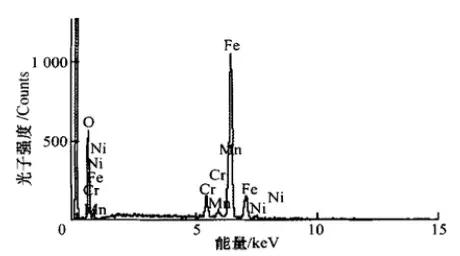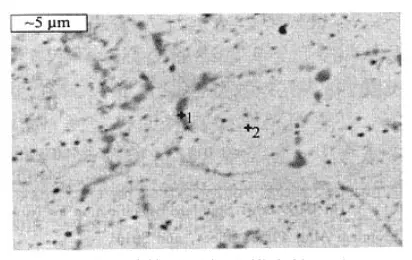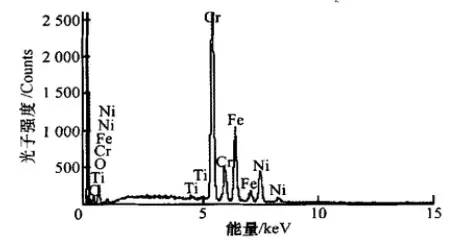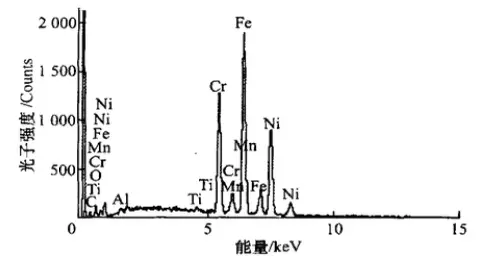Reasons & Countermeasures for Steam Superheating Furnace Gas Collection Pipe Caps
Posted: 07/31/2023 07:56:12 Hits: 8
4. Scanning electron microscope observation and energy spectrum analysis
The black powder remaining in the gas collecting pipe after shutdown was analyzed by scanning electron microscope energy spectrometers, and the results are shown in Figure 7. It shows that the main component of the powder is Fe oxide, combined with the color of the oxide. It is considered that the main component of the oxide is Fe3O4. Analysis shows that the form of corrosion failure is high-temperature oxidation corrosion, and other electrochemical corrosion methods are not the main factor. Figure 8 shows the crystal grains and grain boundary morphology observed under a scanning electron microscope. It can be seen that more second phases are precipitated at the grain boundaries. Point 1 in the figure is the precipitate at the grain boundary, and its composition analysis is shown in Figure 9. Point 2 in the figure is a point inside the austenite grain, and its chemical composition is shown in Figure 10. Comparing Figures 9 and 10, the precipitates are mainly chromium compounds, indicating that the alloying element chromium is not completely dissolved in the austenite, and it is easy to cause chromium-poor grain boundaries, and dense Cr2O3 cannot be formed at the grain boundaries. As a result, the oxidation resistance of the grain boundary is very weak, and intergranular oxidation corrosion is prone to occur.

Figure 7 Energy spectrum analysis results of the chemical composition of black powder

Figure 8 Scanning electron micrograph of matrix tissue

Figure 9 Chemical compositions of precipitated phases at grain boundaries
5. Reasons and countermeasures for failure of pipe caps
According to the results of the chemical composition analysis, the composition of the material is within the allowable range of UNS NO8811, and the materials used are those specified by the design. From the perspective of metallographic structure, inclusions and scanning electron microscope observation, the temperature of the final heat treatment of the pipe cap is not enough or the solid solution holding time is not enough during heat treatment, resulting in the solid solution of the alloy elements, and the alloy compound gathering at the grain boundary hindering the crystallization process. The fine grain strips formed in the original rolling process of the plate are not completely eliminated due to the growth of grains, which weakens the high-temperature strength of the material. The crack morphology on the inner edge of the pipe cap indicates that the failure mode of the material is intergranular cracking, indicating that the grain boundary strength is weaker than the intragranular strength, and the trend of the grooves being closer to the fine grain strips also shows that the fine grain area is easy to be scoured and corroded.

Figure 10 Chemical composition inside grains
The material is a high-temperature-resistant material. According to the current test results, it is considered that no other corrosive medium was introduced during the operation of the device, and the failure of the device was caused by scouring and corrosion. In addition to the presence of fine-grain strips in the matrix structure and the complete solidification of alloying elements of the pipe cap, the high-temperature steam has high flow rate, forming eddy scouring at the blocked part of the pipe cap, which is an important reason for the failure of the tube. To sum up, it is believed that the following methods can be adopted to solve the failure of the air collecting pipe cap:
(1) If the flow rate of steam inlet and outlet cannot be changed, the inlet and outlet pipe head of the branch pipe of the outlet pipeline is transformed into a bell mouth, and the maximum inner diameter of the bell mouth is increased to one or more times the inner diameter of the branch pipe, which can effectively reduce the steam flow rate entering the gas collection pipe, change the steam flow direction, and make the end of the pipe cap not generate vortex.
(2) It is observed that the welding seam is more wear-resistant than the substrate, so a high-temperature oxidation-resistant and wear-resistant welding seam can be surfaced on the inside folding part of the pipe cap to improve the scouring and corrosion resistance of this part. The surfaced welding seam can also make the radius of curvature of the part increases, the wave passes smoothly, and the scouring force of the fluid dispersed.
(3) Strictly control the heat stamping process and solution treatment process of the pipe cap to ensure the temperature and holding time of the solution treatment, so that Cr can be completely dissolved in the austenite, the austenite structure is more uniform, and its scouring and corrosion resistance at high temperature improved.
The black powder remaining in the gas collecting pipe after shutdown was analyzed by scanning electron microscope energy spectrometers, and the results are shown in Figure 7. It shows that the main component of the powder is Fe oxide, combined with the color of the oxide. It is considered that the main component of the oxide is Fe3O4. Analysis shows that the form of corrosion failure is high-temperature oxidation corrosion, and other electrochemical corrosion methods are not the main factor. Figure 8 shows the crystal grains and grain boundary morphology observed under a scanning electron microscope. It can be seen that more second phases are precipitated at the grain boundaries. Point 1 in the figure is the precipitate at the grain boundary, and its composition analysis is shown in Figure 9. Point 2 in the figure is a point inside the austenite grain, and its chemical composition is shown in Figure 10. Comparing Figures 9 and 10, the precipitates are mainly chromium compounds, indicating that the alloying element chromium is not completely dissolved in the austenite, and it is easy to cause chromium-poor grain boundaries, and dense Cr2O3 cannot be formed at the grain boundaries. As a result, the oxidation resistance of the grain boundary is very weak, and intergranular oxidation corrosion is prone to occur.

Figure 7 Energy spectrum analysis results of the chemical composition of black powder

Figure 8 Scanning electron micrograph of matrix tissue

Figure 9 Chemical compositions of precipitated phases at grain boundaries
5. Reasons and countermeasures for failure of pipe caps
According to the results of the chemical composition analysis, the composition of the material is within the allowable range of UNS NO8811, and the materials used are those specified by the design. From the perspective of metallographic structure, inclusions and scanning electron microscope observation, the temperature of the final heat treatment of the pipe cap is not enough or the solid solution holding time is not enough during heat treatment, resulting in the solid solution of the alloy elements, and the alloy compound gathering at the grain boundary hindering the crystallization process. The fine grain strips formed in the original rolling process of the plate are not completely eliminated due to the growth of grains, which weakens the high-temperature strength of the material. The crack morphology on the inner edge of the pipe cap indicates that the failure mode of the material is intergranular cracking, indicating that the grain boundary strength is weaker than the intragranular strength, and the trend of the grooves being closer to the fine grain strips also shows that the fine grain area is easy to be scoured and corroded.

Figure 10 Chemical composition inside grains
The material is a high-temperature-resistant material. According to the current test results, it is considered that no other corrosive medium was introduced during the operation of the device, and the failure of the device was caused by scouring and corrosion. In addition to the presence of fine-grain strips in the matrix structure and the complete solidification of alloying elements of the pipe cap, the high-temperature steam has high flow rate, forming eddy scouring at the blocked part of the pipe cap, which is an important reason for the failure of the tube. To sum up, it is believed that the following methods can be adopted to solve the failure of the air collecting pipe cap:
(1) If the flow rate of steam inlet and outlet cannot be changed, the inlet and outlet pipe head of the branch pipe of the outlet pipeline is transformed into a bell mouth, and the maximum inner diameter of the bell mouth is increased to one or more times the inner diameter of the branch pipe, which can effectively reduce the steam flow rate entering the gas collection pipe, change the steam flow direction, and make the end of the pipe cap not generate vortex.
(2) It is observed that the welding seam is more wear-resistant than the substrate, so a high-temperature oxidation-resistant and wear-resistant welding seam can be surfaced on the inside folding part of the pipe cap to improve the scouring and corrosion resistance of this part. The surfaced welding seam can also make the radius of curvature of the part increases, the wave passes smoothly, and the scouring force of the fluid dispersed.
(3) Strictly control the heat stamping process and solution treatment process of the pipe cap to ensure the temperature and holding time of the solution treatment, so that Cr can be completely dissolved in the austenite, the austenite structure is more uniform, and its scouring and corrosion resistance at high temperature improved.
Post URL: https://www.landeepipefitting.com/reasons-countermeasures-for-steam-superheating-furnace-gas-collection-pipe-caps.html
Landee is a professional industrial pipe fitting manufacturer and be well accepted by customers all over the world, we has been producing Pipe Fitting for a variety of applications since 1985. welcome to access our website: https://www.landeepipefitting.com.
